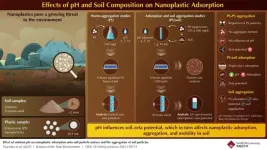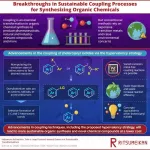Plastics are everywhere—from packaging and textiles to electronics and medical devices. As plastic waste breaks down, it releases microscopic particles that can penetrate our ecosystems, hinder plant growth, and potentially transfer harmful pollutants to organisms, including humans. Therefore, these plastic particles are a potential threat to the ecosystem, especially in their nanoparticulate form (1–100 nm diameter), which can penetrate the environment through different routes, including the soil beneath our feet.
With this in mind, a team of researchers from Japan set out to study the migration behavior of nanoplastics in different soil types. The study was led by Kyouhei Tsuchida, a PhD student from the National Institute of Advanced Industrial Science and Technology (AIST) and Waseda University, Japan, with fellow students Yukari Imoto, Takeshi Saito, and Junko Hara also from AIST, and Professor Yoshishige Kawabe from the Department of Resources and Environmental Engineering, Waseda University. This study was published online in the journal Science of The Total Environment on April 4, 2025.
The researchers focused on the adsorption of the nanoplastics on soil and the aggregation characteristics of both the nanoplastics and soil particles under varying pH conditions. “The aggregation properties of nanoplastics and their adsorption onto soil particle surfaces are known to affect their migration in soil,” notes Tsuchida, “We conducted experiments to analyze these traits to get a better understanding of the migration of nanoplastics.” The research team focused on three major aspects. First, the homo or self-aggregation of the nanoplastics. Second, the adsorption properties of the nanoplastics onto soil, and third, how the adsorption of nanoplastics affects the aggregation of soil particles.
To understand the behavior of the nanoplastics under different soil conditions, the researchers used two different types of soil: andosol (volcanic soil) and fine sand. “Both andosol and fine sand have extremely different properties, and we utilized these two to get a broader idea of how the behavior of nanoplastics changes with respect to soil composition and surface characteristics,” explains co-author Hara.
For the self-aggregation studies of the nanoplastics, the team first prepared a suspension of polystyrene nanoparticles under three different pH conditions. Further, they determined its particle size, aggregate particle size, and zeta potential—a measure of the electrical charge on particle surfaces, which helps determine the stability of nanoparticles.
Additionally, the researchers tested the adsorption properties of the polystyrene nanoparticles onto the two soil types under varying pH conditions. To analyze the adsorption behavior, the researchers used batch adsorption testing. “We used batch adsorption testing to gain a deeper insight into how plastic particles accumulate in soil pores. This property hasn’t been well explained in column studies,” explains co-author Kawabe.
The analysis of aggregation and adsorption involved advanced instrumental techniques, including laser diffraction, UV spectroscopy, and zeta potential analysis. According to the results, no aggregation was observed in the polystyrene nanoparticles owing to the high negative charge on the polystyrene nanoparticles. “The highly negative zeta potential of the polystyrene nanoparticles causes repulsion between the particles and remains unaffected by pH changes,” reports Tsuchida. “This was in contrast to that observed for the adsorption properties of the nanoplastics onto soil. Polystyrene nanoparticles adsorbed onto soil, which was influenced by pH, and further, aggregation of the soil particles.”
The results, therefore, suggest that the soil type and pH of the solution can critically alter the movement of nanoplastics in the soil. Understanding these crucial aspects could help to reform policies and strategies for mitigating plastic pollution.
***
Reference
DOI: https://doi.org/10.1016/j.scitotenv.2025.178712
Authors: Kyouhei Tsuchida1,2, Yukari Imoto1, Takeshi Saito1, Junko Hara1, Yoshishige Kawabe2
Affiliations
1National Institute of Advanced Industrial Science and Technology (AIST), Japan.
2Department of Resources and Environmental Engineering, Waseda University, Japan
About Waseda University
Located in the heart of Tokyo, Waseda University is a leading private research university that has long been dedicated to academic excellence, innovative research, and civic engagement at both the local and global levels since 1882. The University has produced many changemakers in its history, including nine prime ministers and many leaders in business, science and technology, literature, sports, and film. Waseda has strong collaborations with overseas research institutions and is committed to advancing cutting-edge research and developing leaders who can contribute to the resolution of complex, global social issues. The University has set a target of achieving a zero-carbon campus by 2032, which is in line with the Sustainable Development Goals (SDGs) adopted by the United Nations in 2015.
To learn more about Waseda University, visit https://www.waseda.jp/top/en
About Kyouhei Tsuchida from Waseda University and AIST
Mr. Kyouhei Tsuchida is a doctoral student at Waseda University and a researcher at the National Institute of Advanced Industrial Science and Technology (AIST). At AIST, he is a part of the Integrated Research Center for Nature Positive Technology, where his specialization is studying environmental risk and transport phenomena of pollutants. He has co-authored several publications and has presented his work at different international conferences, including the American Geophysical Union's annual meeting in 2023. His key research focuses on environmental risk and transport phenomena of pollutants, including the development of novel methods to measure nano/microplastic concentrations in soil.
END



